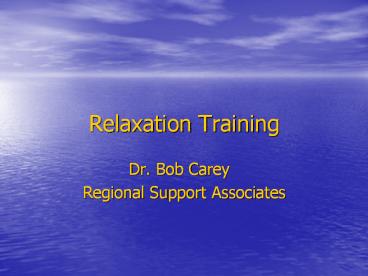Relaxation Training PowerPoint PPT Presentation
1 / 11
Title: Relaxation Training
1
Relaxation Training
- Dr. Bob Carey
- Regional Support Associates
2
Preliminary Steps
- Check that individual is suitable for relaxation
response - Ensure conducive environment
- Ensure staff/caregiver support is available
- Gear the relaxation training to the level of
functioning
3
Teaching Relaxation Therapy
- Establish rapport ensure comfort level
- Include staff/caregiver with the training
- Pick the environment where it is to be done and
establish a routine for practice - Set up expectations and establish the importance
of self-efficacy control
4
Types of Relaxation therapy
- Deep Breathing
- Jacobsen Progressive Deep Muscle
- Cognitive Imagery
5
Deep Breathing
- Gear to level of functioning
- Use teaching techniques role playing,
behavioural rehearsal, positive reinforcement - Dont do too much at once
- Break tasks into small parts and use lots of
practice and repetition
6
Deep Breathing - continued
- Long - Slow Deep breaths
- Each breath as long as possible aim for 10
seconds or longer - Try to hold breath on inhale for 3-4 seconds
- Practice for 10-15 minutes
- Practice with individual and do together
7
Deep Muscle Jacobsen technique
- Tension release exercises
- Modified for persons with intellectual impairment
- Ensure proper positioning
- Teach/instruct in technique first
- Practice one muscle group at a time
- Use modelling, instruction, and some verbal and
physical cues/prompts
8
Deep Muscle - continued
- Remember to script for success talk about the
importance of learning this new skill - Muscle groups to practice hands, forearms,
biceps, calf, thigh, stomach, shoulders,
neck/jaw/cheek, forehead/eyes.
9
Deep Muscle - continued
- Focus on the difference between tension and
feelings of relaxation notice the difference - Therapist voice modulation flat, little
intonation, relaxing, pacing is slow, breaks in
sentences dont talk too much - Allow for 30 to 40 minutes depending on
individual - Lower functioning shorter duration focus on
relaxed posture/appearance
10
Cognitive Imagery
- Develop this with individual prior to starting
find out what works for them - Use descriptive phrases/scenarios that employ all
five senses
11
Scripting for Success
- Teaching new skill to control stress/anger
like riding a bike practice makes perfect - Make Audio tape
- Enlist staff as collaborators/facilitators in
making it work provide good role modelling,
reinforcement for using it

